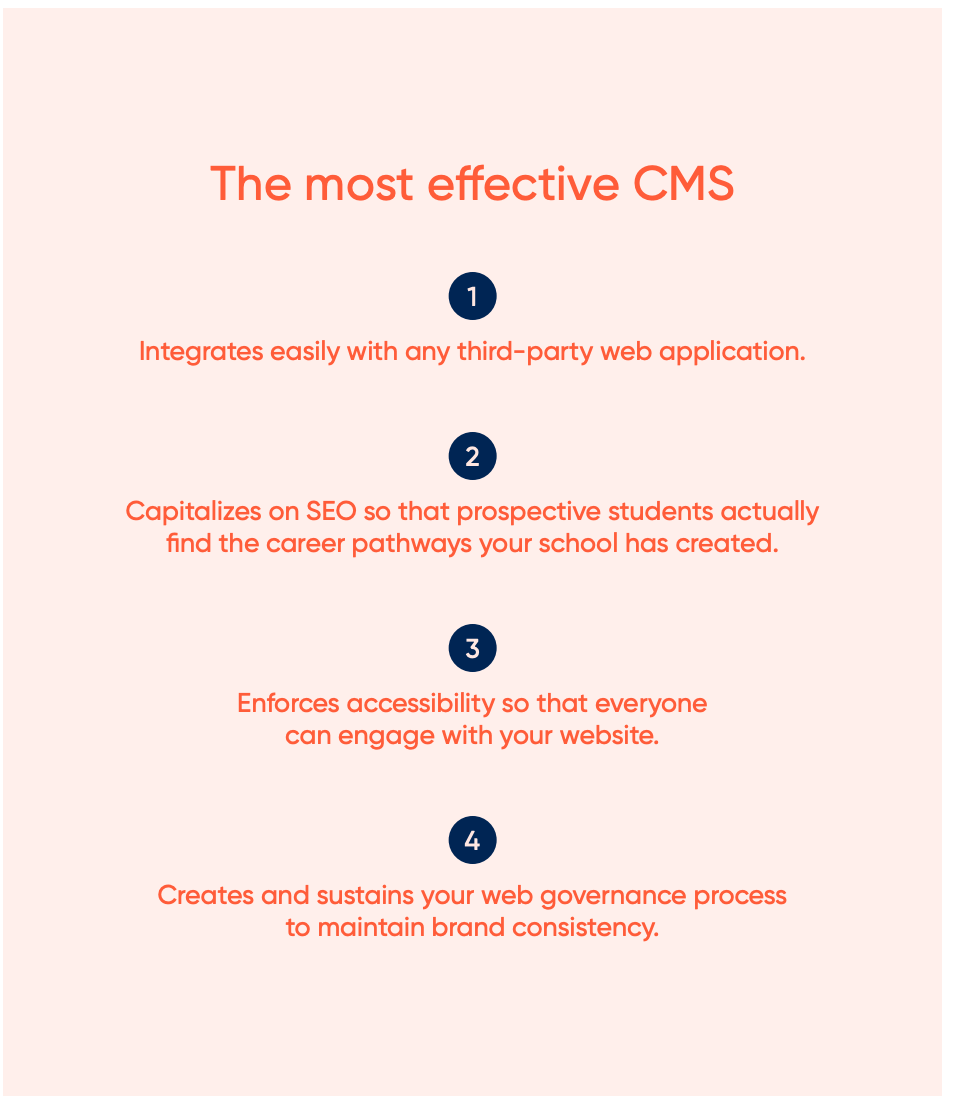Introduction
In the 2010s, higher education recognized that the traditional approach to education delivery wasn’t working. Despite good intentions, the community college cafeteria-style approach that provided students with the flexibility of picking and choosing courses only led to confusion, complexity, and disconnectedness.
Four-year colleges and universities faced other challenges, including a decrease in prospective student populations, drop in the perceived value of a college degree, reduced student retention, low graduation rates, and increasing expectations for a modern consumer experience. The result is a generation of learners with student loan debt and an accumulation of courses but no degree to show for either.
Consequently, administrators grappling with alternatives to such an outdated delivery model have turned their focus to a new standard, rich personalization and career pathways software, as a way to help students better navigate the higher education system while also working toward a program with relevancy in the current job market. After all, today’s learners —from ages 18 to 80, from undergraduates to career professionals—all want one thing: to connect their educational experience to a sustainable and enriching career.
This whitepaper highlights how your school can implement a massively personalized digital student engagement strategy using your most powerful tool—your website—to guide students through a career pathway from enrollment to graduation and later, as a lifelong learner.
Download Whitepaper PDF
The outdated educational pathway
This is the traditional trajectory for higher education students. The problem, however, is that students haven’t always been sure where their major leads to professionally, and they have considered out-of-touch campus career centers to be of little help.
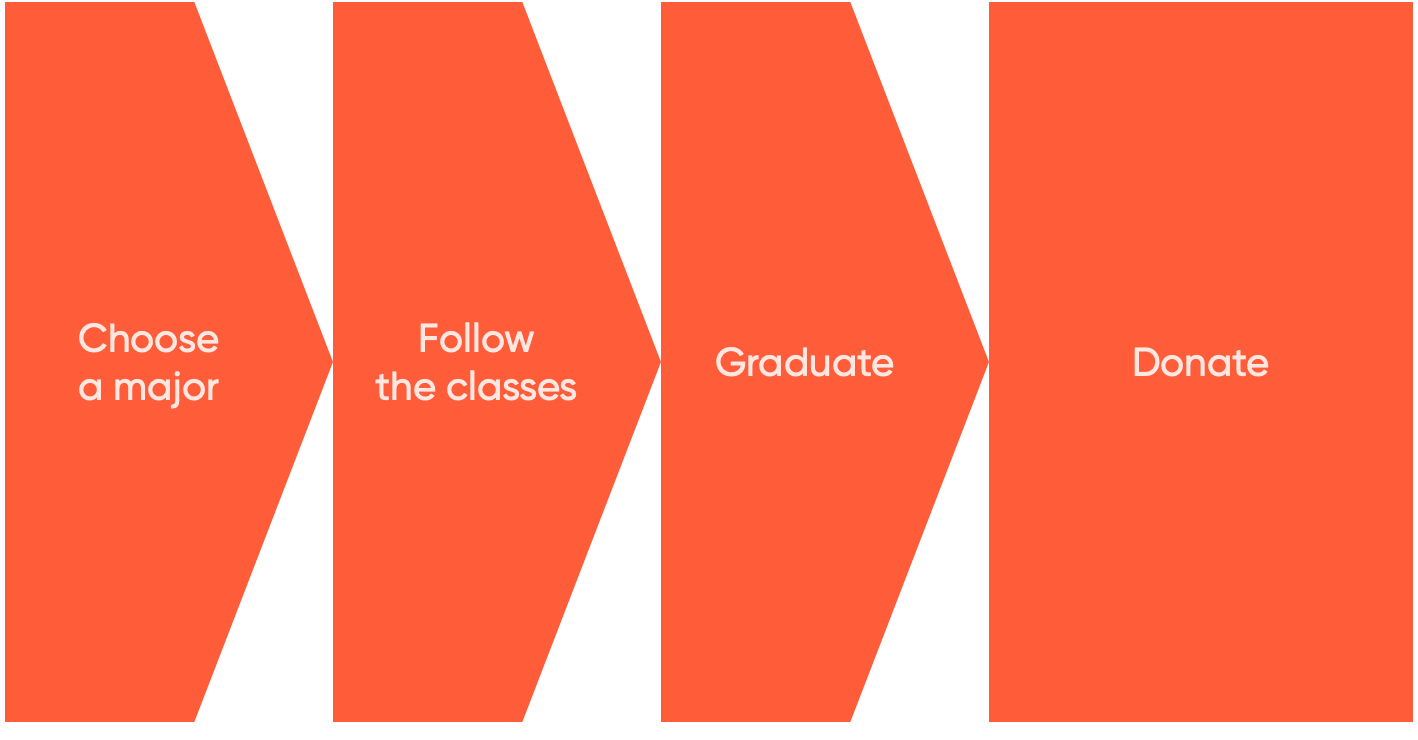
What’s more, students don’t always see the connective links that tie their education programming and careers together. For example, in a recent survey by Strada’s Center for Education and Consumer Insights, only 7% of college or university students and 17% of community college students rate their institution as “excellent” or “very good” at helping them connect their education path to a career.
To maintain relevance, higher ed institutions can no longer rely on a two- or four-year engagement with students—they must adapt by providing a highly personalized pathway.
Community colleges took a different approach. With funding tied to degree enrollment, they enticed students to campus with flexibility and choice. But rather than carving out their own paths, students became overwhelmed by the variety, choosing classes they were interested in but that didn’t add up to a degree.
The result? Fewer than 40 percent earned a certificate or degree within six years of enrollment, and most dropped out of school altogether.
As funding models have shifted from access-oriented to performance-based (i.e., from students-in-seats to credential attainment), the focus on retention and completion has become even more important. Furthermore, career longevity in today’s ever-changing world requires more than a college degree.
To maintain relevance, higher ed institutions can no longer rely on a two- or four-year engagement with students—they must adapt by providing a highly personalized pathway that addresses the needs of today’s modern learners over the entire course of their career journey.
Understanding career pathways
Fewer than one in three adults who don’t currently hold a postsecondary degree say they have a clear understanding of available career pathways. What’s more, seven out of ten freshmen are interested in understanding the qualifications needed for certain occupations.
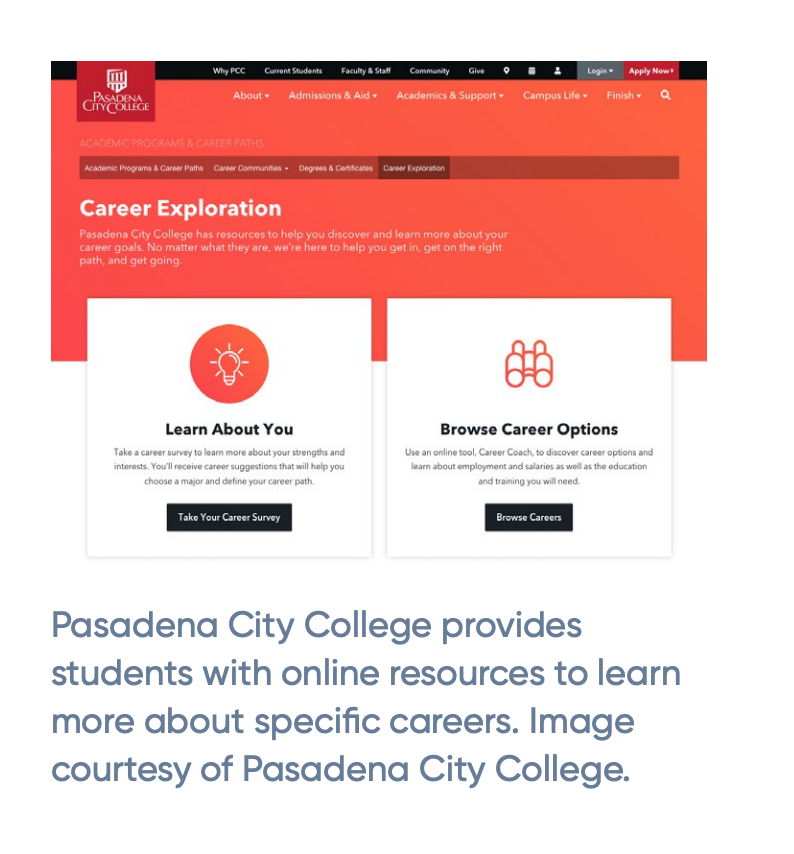
In other words, every student wants to know: is this college program “worth it?”
Statistics like these prove that more than ever, colleges and universities must rise to the challenge of designing career pathways that guide students from high school to enrollment to graduation and ultimately, to the workforce and beyond.
According to Cheryl Hyman, a former community college chancellor and author of Reinvention: the Promise and Challenge of Transforming a Community College System, community colleges and universities must create tighter linkages.
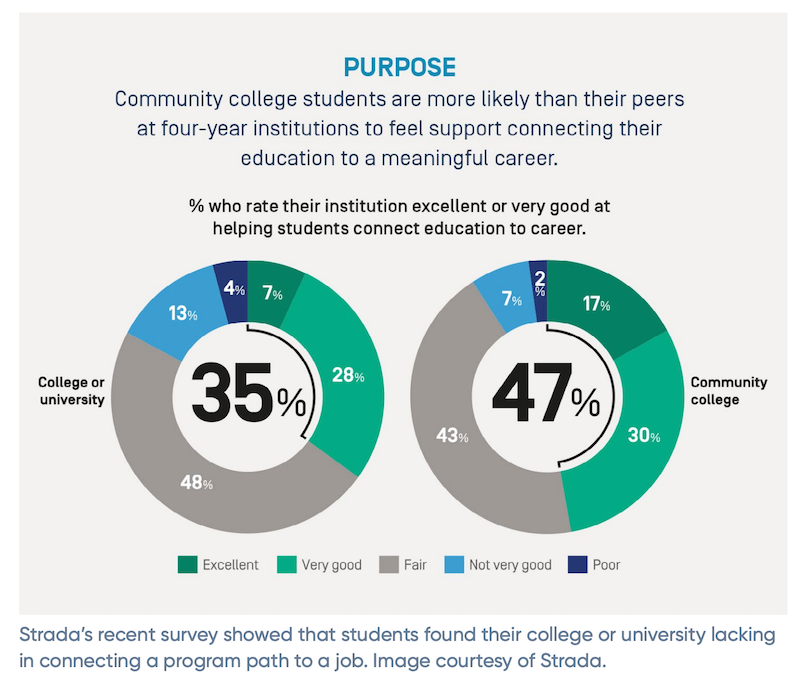
Hyman says that colleges and universities “must align their systems and structures to provide each student with accurate information about both their programs of study and the careers and fields with which they are affiliated” to help students attain higher education, self-improvement, and meaningful careers.
This is accomplished by clearly aligning educational programming of all types to career outcomes. Students should have a clear picture—from their first visit to the college website—of the range of offerings relevant to them, what kinds of credentials they lead to, and how those credentials will help them achieve their career goals.
By taking this approach, which brings student return-on-investment to the forefront, higher education providers can accomplish a number of goals.
- They will likely see an increase in enrollments stemming from a clearer understanding of the value of educational investment.
- They will likely achieve higher retention and attainment rates, because students are enrolling with a clear picture of the end in mind.
- They’ll likely see an increase in student earnings and appropriate employment after completion.
- Finally, they’ll also see more opportunities to engage past students with ongoing and continuing education since those learners will have experienced firsthand the impact of the institutional commitment to helping them achieve their career goals.
Of course, establishing this kind of outcome-oriented model cannot happen in a vacuum. Executing on the vision requires a digital infrastructure—including a content management system (CMS) and flexible registration system—that’s actually powerful enough to support these endeavors.
Such a seismic shift in education delivery is no easy task, but it can’t be skipped.
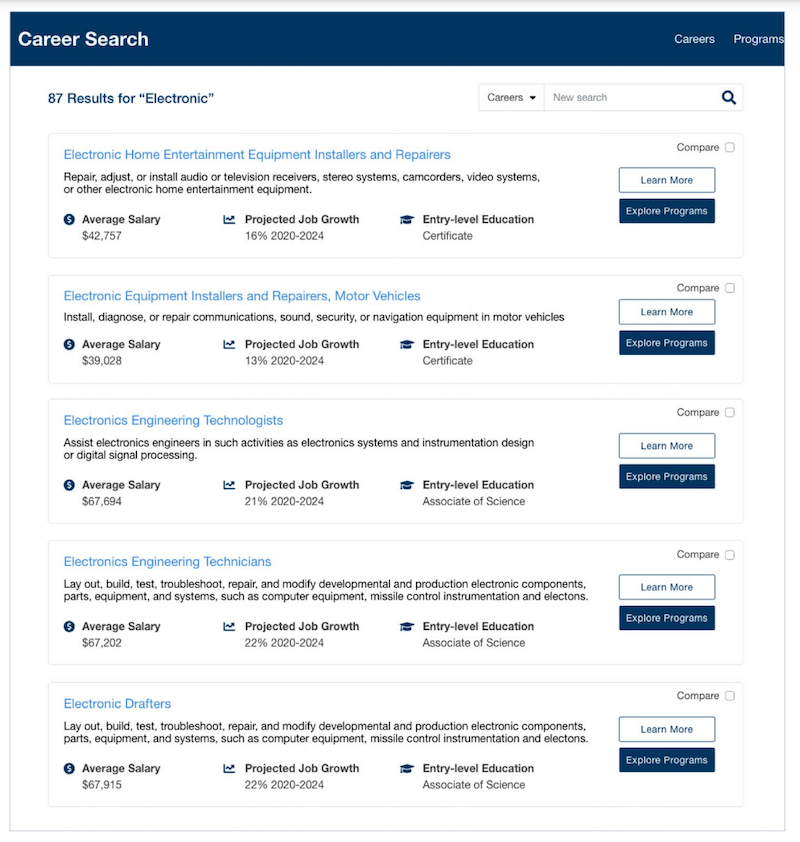
Identifying curriculum maps, competencies, and learning outcomes form a framework for building comprehensive pathways and encourages student engagement. To stop there, however, is to get trapped in an outdated model of education with no consideration of students’ lifelong learning needs.
For a more holistic model, the next step is to carve out a better path by creating a great learner experience where the student journey is “supported and as technologically enhanced and rapid as it can be.”
Two of the most effective ways to do this are allowing students to explore specific careers and programs and providing them with real-time information on the current job market.
College is expensive, and it doesn't make much economic sense to have a student find themselves while receiving higher education, like it used to be 50 years ago.
Career and Program Explorer
Regardless of age, a student engages with your website to educate themselves about the possibilities that await through education. This is true for an 18-year-old with no idea about which majors lead to which careers as well as a 41-year-old looking to upskill through a continuing education program.
“College is expensive, and it doesn't make much economic sense to have a student find themselves while receiving higher education, like it used to be 50 years ago,” said Ann Buchele, Vice President of Academic and Student Affairs at Linn-Benton Community College. With a well-defined career pathway, a student can clearly connect their education to their labor market goals.
Including a dynamic career and program explorer in your academic and program pages lets students search by program or career title to learn what your school offers to help them land a job or advance in their career.
They can generate reports between jobs that compare costs, the time to complete the program or certificate, or median salaries. They can also see top employers in each field and view top skills needed. Armed with this type of information, students better understand the return on investment in terms of potential career and salary outcomes if they enroll in a major or certification program.
It’s no longer enough to simply map out programs and courses and then send students on their way. More than ever, students and parents view higher education as a means to an end—getting a job. They want relevant, up-to-the-minute information about where particular knowledge and skill sets lead.
To help students reach their goals, it is imperative that key job market data be embedded throughout your academic program and certificate web pages.
Providing a comprehensive curriculum-to-career view allows students to:
- Align learning with career objectives.
- View labor market intelligence simultaneously with program and certificate catalog information.
- Make informed career decisions with real-time data such as the number and type of current job postings, estimated job growth, median income, top job titles, and average salaries for a particular field.
And students aren’t the only ones who benefit. When your website features information-rich academic and program pages, it encourages student engagement, stickiness, and ultimately, conversion.
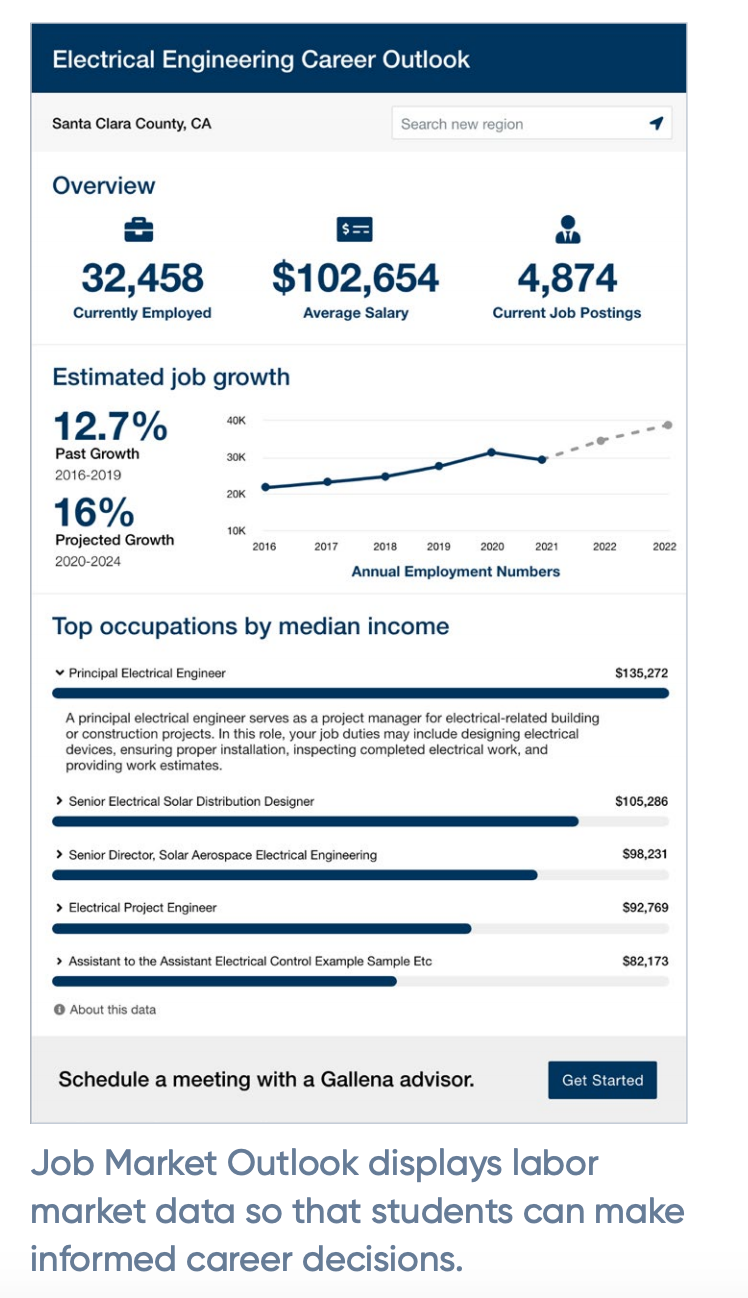
If your institution is to thrive, it must turn transactional services into transformational interactions.
For far too long, colleges and universities focused enrollment on the annual pool of high school graduates, and any interaction with students was viewed as little more than one-time, transactional occurrences that ended upon graduation.
We know it’s critical to develop educational programming that supports people at every stage of their lives. However, accomplishing this takes more than lip service. Delivering a true 60 Year Curriculum requires college and university leaders to be creative and flexible in credential and programming diversity, and to emphasize flexibility and personalization.
If your institution is to thrive, it must turn transactional services into transformational interactions. Incorporating career and program explorer and job market outlook resources are effective at expanding the path and including learners no matter where they are on their academic or career journey.
But make no mistake: legacy systems and a lack of modern technology and experience will only frustrate your efforts and drag out attempts to modernize. There’s no time to waste in laying a strong foundation with a content management system that allows you to create dynamic pathways that embrace the lifelong learner.
3 Ways Website Personalization Drives Engagement in Higher Education
Nearly 70% of students now cite the school’s website as the main influence on their decision-making.
When modern learners visit your website, they expect a highly relevant, personalized experience with curated content and next steps aligned to their needs and desires. And they want the information delivered immediately. As a result, your website must model the expediency and choice of Amazon or Netflix to hold students’ attention and keep them on their pathway.
Furthermore, the Amazon effect hasn’t just disrupted the retail industry—it’s dramatically changing the way colleges and universities interact with students. Inter-institutional competition has forced schools to rapidly become marketized, especially online. Nearly 70% of students now cite the school’s website as the main influence on their decision-making.
This lies in stark contrast to the fact that six in ten students say that of all companies they engage with online, their college is the furthest behind in personalizing their experience. It’s no secret that students want and demand service that’s friendly, immediate, accurate and goes the extra mile.
The future of the modern campus is personalization at every touchpoint, whether it is through the application of technologies such as AI or providing concierge services that remove the friction between the learner and an institution’s academic offerings. This type of evolved engagement begins with a student-first approach to ensuring that every interaction with your college or university is positive and affirming.
Research has shown that to drive website visitor engagement and conversion, your college or university must deliver a personalized educational experience. It’s time to move away from the ineffective one-sizefits-all model and toward a “right for me” personalized experience.
Personalization, just as it is in other industries, is ongoing in higher ed, an evolution that becomes more individualized with market segmentation. However, there are small steps that have a big impact. Rather than personalizing messages to 150 prospective students who viewed a web page, a time-consuming task that is also code-heavy, consider implementing personas that capture five or six dynamic personas.
“At the end of the day, students are our customers,” said Lesley Nichols, Executive Director of Professional Studies at Emerson College. “This is an opportunity for everyone who works with students—whether it’s the admissions office, alumni relations, faculty members, staff. This is the time to figure out who your audience is, what you’re missing, and how you can use digital tools to further that mission.”
Building persona-based templates
Personas are detailed descriptions of each type of person who visits your website. It can include demographics, location, career intent, student type, and virtually any other piece of information that helps you better understand your audience. Each persona represents a cluster of users with similar values, behaviors, and motivations. Parents, transfer students, first-generation students, and continuing education students are all different types of personas.
Alternatively, schools can set up common objectives such as “earn a degree to launch my career,” “learn English as a second language” or “earn certifications for career growth.” The point is to provide learners with a starting point for exploring so that they can self-select the pathway that’s right for them.
To be prepared for a persona-based approach, Jennifer Goolsby, Director of Instructional Technology for Midland College, started by implementing a feature-rich content management system as the backbone of her school’s website redesign project.
Then, the Midland team “began by laying out the steps for each path so that students could feel like they had a personalized academic plan,” said Goolsby. “We thought about all the stumbling blocks we’ve seen over the years and made sure to include information on how to get around them. Our goal was for every step to lead naturally to the next step in their journey.”
College and University Website Redesign: The Ultimate Guide
If your campus has yet to adopt a career pathways approach to education delivery, or if digital personalization is nonexistent, the good news is that your website has the potential to be a go-to tool for creating the desired interactivity with learners. And when coupled with a powerful CMS, you’ll be able to implement dynamic pathways supported by email, social engagement, and brand consistency that already deliver some aspects of a personalized student experience.
Having a flexible, dynamic CMS at the ready simplifies the integration of robust career pathways into flexible and market-responsive academic and program offerings.
Beyond the CMS, you need a powerful eCommerce-enabled registration system that transforms your website into an enrollment engine.
With this technologically advanced digital infrastructure in place, your institution will stand out to a wide range of learners, help them find the offerings most relevant to them when they land on your website, and then simplify the registration process once they find the right program for them.
Buyer's Guide: Practical advice for choosing your next (or first) higher education CMS
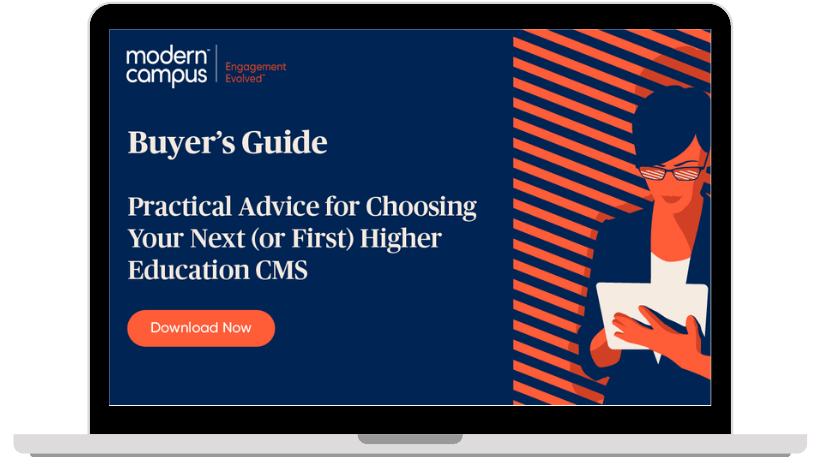
As long as all of your decisions revolve around what is best for that student, you’re going to do the right thing.
The career pathways model is a clear, direct way for colleges and universities to guide learners through the often confusing path of academia to the workforce and beyond. Personalizing the experience simply keeps learners on the pathway.
A thoughtful digital student engagement strategy that maximizes both pathways software and personalization drives engagement and enrollment growth. It provides prospects and students with “right for me” information that helps them meet their goals. And most of all, it equips your college or university with the tools it needs to engage with and meet the needs of the lifelong learner.
“As long as all of your decisions revolve around what is best for that student, you’re going to do the right thing,” said Buchele, from Linn-Benton College. “Keep the student at the forefront of all of your decisions.”
Learn more about Modern Campus
Choose higher ed’s first cloud-based, end-to-end student engagement platform.
Because modern learners demand it. And your enrollment growth depends on it.

Tackle your biggest challenges
Download Whitepaper PDF
Related Resources

Blog
How Clarifying Career Pathways Drives Student Success
Learn why your student management system needs to prioritize guided pathways.

Blog
Are You Delivering the Digital Experience Your Students Expect?
In a seamless online experience, the customer finds what they need at every stage of the transaction.

Blog
4 Keys to Engaging the Modern Learner
Deliver the experience modern learners expect with a modern campus.
